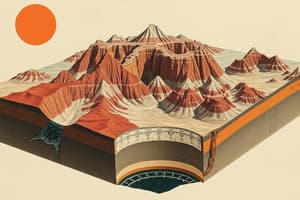Podcast
Questions and Answers
Match the landform with its description:
Match the landform with its description:
Mountain = Large landform typically higher than 600 meters with steep slopes and high peaks Plateau = Expansive, high-elevated area of land rising steeply above surrounding terrain with flat, nearly level surfaces
Match the following mountains with their locations:
Match the following mountains with their locations:
Mount Everest = Himalayas Mount Kilimanjaro = Africa Mount Denali = Alaska
Match the landform with the process that typically forms it:
Match the landform with the process that typically forms it:
Mountain = Can be formed by tectonic forces, volcanic activity, or erosion Plateau = Typically formed through tectonic processes like uplift of Earth's crust or sinking of a continent
Match the unique characteristic with the landform:
Match the unique characteristic with the landform:
Study Notes
Landforms are geological features of the Earth's surface, including various types of terrain such as hills, valleys, plains, plateaus, and mountain ranges. These landforms are shaped by various geologic processes, including tectonic activity, erosion, and weathering.
Mountains
Mountains are large landforms, typically higher than 600 meters (2,000 feet) above the surrounding terrain and often characterized by dramatic changes in elevation. They can be created by tectonic forces, volcanic activity, or erosion. Some of the tallest mountains in the world include Mount Everest in the Himalayas, Mount Kilimanjaro in Africa, and Mount Denali in Alaska.
Mountains often have steep slopes, narrow ridges, and high peaks. They can have diverse ecosystems, with unique flora and fauna adapted to the harsh conditions. Many mountain ranges also have significant cultural and touristic importance, such as the Rocky Mountains in North America or the Alps in Europe.
Plateaus
Plateaus are expansive, high-elevated areas of land that rise steeply above the surrounding terrain on at least one side. They are often characterized by flat, nearly level surfaces and can be millions of square kilometers in size. Some of the largest plateaus in the world include the Tibetan Plateau, the Colorado Plateau, and the Deccan Plateau.
Plateaus are typically formed through tectonic processes, such as the uplift of the Earth's crust or the sinking of a continent into the mantle. They can also be created by volcanic activity or the deposition of sedimentary rocks.
Plateaus often have unique ecosystems and are home to a variety of plant and animal species. They can also have significant economic and cultural importance, as they often contain valuable natural resources and are home to many indigenous communities.
Studying That Suits You
Use AI to generate personalized quizzes and flashcards to suit your learning preferences.
Description
Test your knowledge on the formation and characteristics of mountains and plateaus, two major types of geological landforms. Learn about their unique features, ecosystems, and cultural significance shaped by tectonic forces and other geologic processes.



